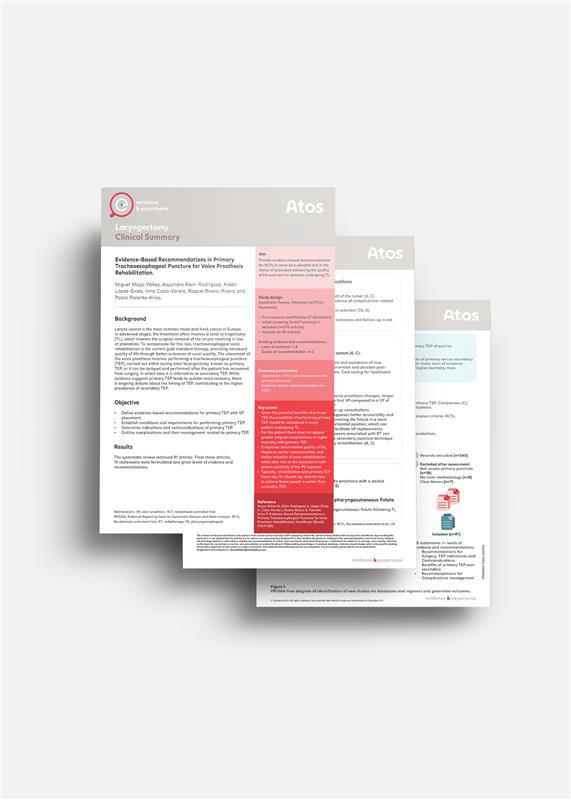What is Tracheoesophageal Puncture?
Tracheoesophageal puncture (TEP) is a surgical procedure designed to help individuals who have undergone a total laryngectomy (TL) regain their ability to speak. This procedure involves creating a small hole between the trachea (windpipe) and the esophagus (food pipe) to insert a voice prosthesis.
What are the different types of TEP?
The TEP procedure can be performed in two ways: primary and secondary puncture.
- Primary Puncture: This is done during the total laryngectomy surgery. After the larynx is removed and a permanent opening in the neck (tracheostoma) is created, a puncture is made through the back wall of the trachea into the front wall of the esophagus and a voice prosthesis is inserted. This method allows for early voice rehabilitation, enabling patients to speak within a few weeks post-surgery. (Sinclair et al., 2011, Maniaci et al., 2023)
- Secondary Puncture: This procedure is conducted after the initial laryngectomy surgery, when the patient has recovered. The puncture procedure is similar, but additional considerations need to be taken, such as use of a rigid endoscope for protection of the pharynx.

What is tracheoesophageal speech and how does it work?
Tracheoesophageal speech (TES) is a method of voice restoration that requires a tracheoesophageal puncture. A voice prosthesis is placed in the puncture, and when the patient occludes their stoma, air from the lungs is directed through the voice prosthesis into the esophagus. This air causes the pharyngoesophageal segment to vibrate, producing sound that can be shaped into speech by the tongue and lips.
Clinical evidence shows that voice rehabilitation with TES has a high success rate, provides high voice-related Quality of Life and decreases depression in patients who have undergone a TL.
(Polat et al., 2014, Moukarbel et al., 2011, Chone et al., 2005)
Clinical Summary of Evidence-Based Recommendations in Primary Tracheoesophageal Puncture for Voice Prosthesis Rehabilitation
In 2024, Mayo-Yáñez et al., published a Systematic Literature Review on the topic of Tracheoesophageal Puncture. The aim of the publication is to provide evidence-based recommendations for the procedure of primary TEP, as well as determine the indications and contraindications of primary TEP. This Systematic Review provides HCPs with a valuable overview of the multiple advantages of primary TEP over secondary TEP and can be used to guide clinical decision making to enhance the quality of life for all patients undergoing a total laryngectomy.
There is a Clinical Summary of the Systematic Literature Review, highlighting the key points, recommendations of the authors and conclusions.

Clinical Evidence Series: Primary vs. Secondary Puncture
The Clinical Evidence Series (CES) from Atos Medical are documents on a specific topic, describing and summarizing the most relevant literature.
There is a CES on the topic of primary vs. secondary tracheoesophageal puncture available. It introduces the subject, covering commonly discussed themes, as well as presenting the clinical evidence regarding the benefits of performing primary puncture and a comparison of the complications associated with both procedures.
Fill out the form to receive our latest CES on the topic of tracheoesophageal puncture – it will be sent to your e-mail.
*required fields
This site is protected by reCAPTCHA and the Google Privacy Policy and Terms of Service apply.
Further reading
Discover more about tracheoesophageal puncture and the Provox Vega Puncture Set
Primary puncture
Considerations when choosing between primary and secondary tracheoesophageal puncture (TEP)
Primary Puncture
Secondary Puncture
Considerations when choosing between primary and secondary tracheoesophageal puncture
Secondary Puncture
Provox Vega Puncture Set
The disposable surgical set for primary and secondary placement of the Provox Vega.
Provox Vega Puncture Set
References:
Chone CT, Gripp FM, Spina AL, Crespo AN. Primary versus secondary tracheoesophageal puncture for speech rehabilitation in total laryngectomy: long-term results with indwelling voice prosthesis. Otolaryngol Head Neck Surg. 2005 Jul;133(1):89-93.
Maniaci A, La Mantia I, Mayo-Yáñez M, Chiesa-Estomba CM, Lechien JR, Iannella G, et al. Vocal rehabilitation and quality of life after total laryngectomy: state-of-the-art and systematic review. Prosthesis. 2023;5:587-601.
Mayo-Yáñez M, Klein-Rodríguez A, López-Eiroa A, Cabo-Varela I, Rivera-Rivera R, Parente-Arias P, et al. Evidence-based recommendations in primary tracheoesophageal puncture for voice prosthesis rehabilitation. Healthcare. 2024 Mar;12(6):652.
Moukarbel RV, Doyle PC, Yoo JH, Franklin JH, Day AM, Fung K. Voice-related quality of life (V-RQOL) outcomes in laryngectomees. Head Neck. 2011;33(1):31-6.
Polat B, Orhan KS, Kesimli MC, Gorgulu Y, Ulusan M, Deger K. The effects of indwelling voice prosthesis on the quality of life, depressive symptoms, and self-esteem in patients with total laryngectomy. Eur Arch Otorhinolaryngol. 2015;272(11):3431-7.
Sinclair CF, Rosenthal EL, McColloch NL, Magnuson JS, Desmond RA, Peters GE, et al. Primary versus delayed tracheoesophageal puncture for laryngopharyngectomy with free flap reconstruction. Laryngoscope. 2011 Jul;121(7):1436-40.
PM37310_ThEN_202503
PM37310_ThEN_202503
Share
Save to my content